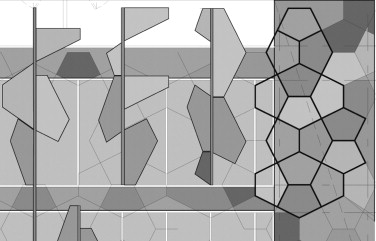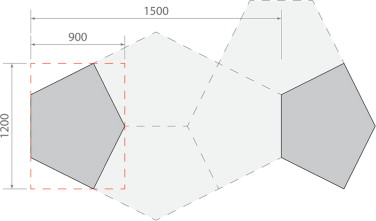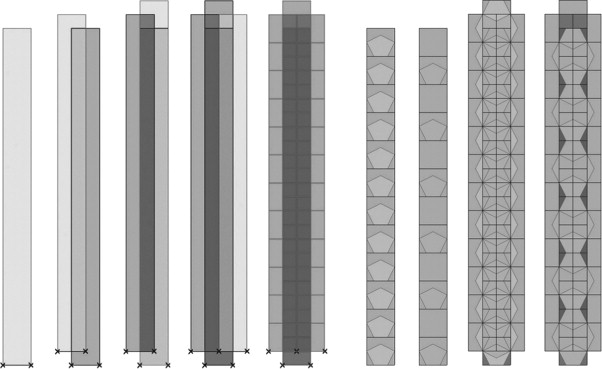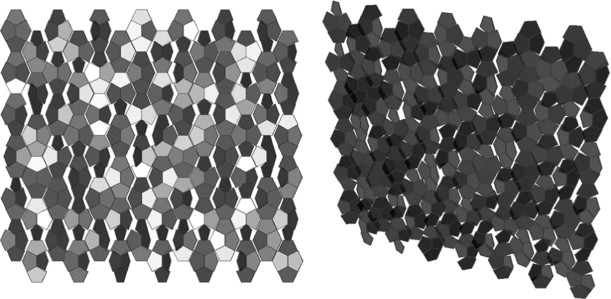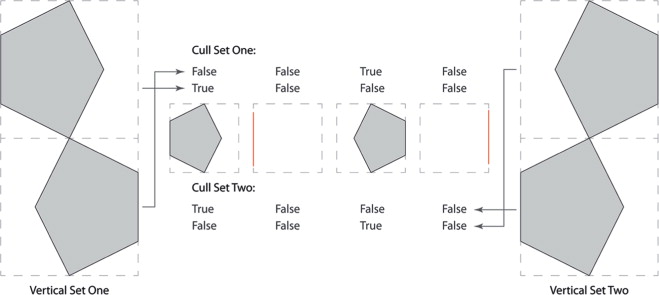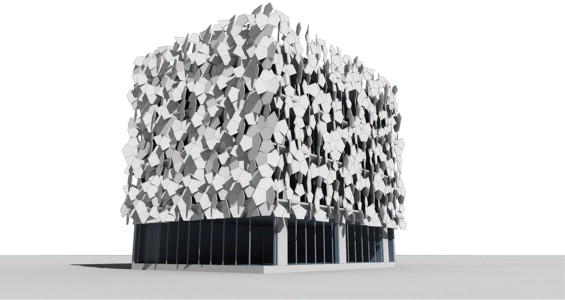Abstract
This paper reports on the design and control of a responsive envelope based on the rotation of tessellated components. The study investigates responsive and dynamic approaches for building facades and envelopes to regulate solar shading, light control, views and thermal gain within the building. It is well known that near real-time visual output from computational simulation can significantly impact the prediction of dynamic building-environment interactions and lead to the development of smart, adaptable, net zero energy buildings. To address these motivations, this paper reports the development of an experimental simulation of a responsive envelope based on using a 4-fold penttile scheme. The simulation is developed using a novel pentagonal approach involving component (tile) design, tessellation and control methods. The paper further elaborates on the geometry and control aspects of the facade subdivision and presents the results of applying this tessellation geometry to a building envelope shading study based on facade components with rotation. Finally, it tests the “responsiveness” to multiple performance metrics by applying a non-deterministic exploration method for the stochastic rotation of individual panels. The sophisticated evaluation of alternative envelope configurations for a set of performance criteria require a tighter computational coupling between modelling and control of dynamic geometry.
Keywords
Facade tessellation ; Stochastic rotation ; Responsive envelopes ; Moveable facade components ; Parametric modelling
1. Introduction
The built environment faces increasing demands for design and analysis tools that reduce energy footprints and establish reliable and accurate performance measures for buildings. However the feedback loop between the results of analysis and subsequent the changes to the design remains a time consuming and iterative process. Recent advances in computational simulation, particularly the manipulation of dynamic geometry, promise a tighter coupling between the design and evaluation phases of buildings. Developing adaptive, responsive low-energy architecture requires a better understanding of the complex interaction between envelope geometry and its performance metrics (Hudson, 2008 ). In this paper, we investigate the possibilities of dynamic change models and their potential for developing a simulation of a responsive building envelope. The design and development of a tessellation study based on facade components with rotation is reported. The rotation methods are based on stochastic rotation of panels, primarily responding as a shading device to reduce thermal gain within the building. This paper reports on the geometry and control aspects of facade subdivision using 4-fold penttiles (Cairo pentagonal tiling), a dual semi-regular tiling of the Euclidean plane. The penttile method reported in Hanafin and Datta (2012) is used here to define the facade pattern and its subdivision into discrete components.
New advances in the geometric and parametric representation of building envelope (Pottmann, 2007 ; Woodbury, 2010 ) new construction materials (Schittich, 2001 ) and control technologies for adaptive buildings combined with advances in the field of design space exploration (Woodbury et al ., 1999 ; Aish and Woodbury, 2005 ; Datta, 2006 ; Woodbury, 2010 ) now permit the sophisticated evaluation of alternative designs for optimisation of a set of performance criteria (Radford and Gero, 1988 ).
However, current models lack the ability to handle envelopes of variable geometries (Kolarevic, 2004 ) and do not account for local variations in climate conditions and do not include multi-skin facades (Desai, 1992 ). Tools that calculate the performance requirements (solar gain, daylight penetration, heating and cooling loads, ventilation, water use) of a building (Shaviv, 1999 ) require an extensible geometric representation (Malkawi, 2004 ; Hudson, 2009 ). It is anticipated that rapid, near real-time visual output from such representations would significantly improve the prediction of performance and enable the optimisation of smart, adaptable, net zero energy buildings (Hensen, 2004 ). To address these limitations in a unified way, this paper reports on developing a responsive envelope based on the tessellation of 4-fold penttiles (Datta et al., 2009 ). Further, it addresses the problem of responsiveness to multiple criteria by applying a non-deterministic exploration method for the rotation of individual panels (Hanafin et al., 2009 ).
The challenge of developing adaptive, responsive low-energy architecture requires new knowledge about the complex and dynamic interaction between envelope geometry and optimisation of performance metrics (Hudson, 2008 ). In this paper, we present the results of a building envelope tessellation study based on facade components with rotation. The rotation methods are based on stochastic rotation of panels, primarily responding as a shading device to reduce thermal gain within the building.This paper reports on the geometry and control aspects of facade subdivision using 4-fold penttiles (also called as Cairo pentagonal tiling), a dual semi-regular tiling of the Euclidean plane. The penttile method reported in Hanafin and Datta (2012) is used here to define the facade pattern and its subdivision into discrete components.
2. Problem statement
To motivate the discussion, of a responsive building envelope, we based our parametric development of a facade tessellation on the recently completed “pixel” building in Melbourne. The building was designed with the goal of being a carbon neutral office building and to be used as a prototype for sustainable and environmental buildings. The facade “pixels” are one of the devices used in the building to significantly improve its environmental performance. The facade involves a series of jumbled coloured and textured fixed panels that act as an aesthetic to the building facade and as a shading device to reduce thermal gain within the building. Each panel is designed to be positioned and angled in a fixed location based on optimal shading in the Melbourne climate. Panels will not only reflect or absorb the sun, but also allow views out from the building with perforation and transparency in the materials. In order to further optimize performance, the problem of component motion with respect to changing conditions needs to be addressed.
To address this problem, we initially developed the facade subdivision scheme from first principles to investigate its responsiveness to environmental conditions and present our findings. Further to the development of a parametric model, the stochastic rotation of the south facade of the pixel building is undertaken in order to facilitate understanding of the shapes and rules which determine the facade composition. This elevation consisted of jumbled panel facade and precast panels with the cast patterns (Figure 1 ). The tiling used on the elevations is identified as a Cairo pentagonal tiling, which is a type of polygonal isohedral types of tiling by pentagons (Grünbaum and Shephard, 2013 ).
|
|
|
Figure 1. South elevation with Cairo tiling overlaid in bold showing the 4-penttile structure.(Source : VDM Consulting). |
3. Multiple support method
The Cairo tiling is classified as a regular tiling (each pentagon is identical) of the plane. However, as the orientation of each pentagon changes, this presents issues with surface-component application in conventional parametric modelling tools (Datta et al, 2009 ). With this in mind, a multiple support method is described that generates an underlying support structure, allowing for the orientation property of four individual pentagons to be applied correctly.
3.1. Component design
The geometry of the initial pentagon has a bounding box dimension of 1200 by 900 and a spacing of 1500, which does not replicate into a uniform surface grid (Figure 2 ). In order to correct this, the overall component needs to be developed to replicate within a uniform surface grid. If the surface grid is developed using the width of the pentagon, 1200, the replication becomes more manageable and simply requires control over the positioning of the pentagon within the grid. In order to ensure this correct placement, a spacer is used at the apex of the pentagon which results in the overall bounding box dimensions of the component being 1200 by 1200.
|
|
|
Figure 2. The fixed dimensional structure of the pentagons showing shape, orientation and offset of the tiling pattern. |
3.2. Tessellation method
The first step in developing the overall tiling is to establish the surface geometry of a single vertical set of tiles, beginning with the bottom pentagon from the hexagonal collection. A horizontal line was created based on the width of the tile unit. From the start and end points of this line, two vertical lines were created with an initial length of 14.4 m. Between the two vertical lines a base surface could now be generated. The base surface was then subdivided using its U and V parameters. In the case of the U parameter that is one as this surface carries a single set of vertical tiles. With the first supporting surface established, three more are required and can be achieved by offsetting the first. Moving in a clockwise direction the offsetting can be undertaken (Figure 3 , left) by adjusting the start point of the baseline from 0, 0, 0 to −0.6, 0, 0.6 (left); 0, 0, 0 (top); 0.6, 0, 0.6 (right). When the component is applied to the supporting surfaces, a pentagon is generated in each of the polygons resulting in multiple pentagons that overlap. Using a data list method, the excess tiles are culled, leaving the desired pattern. The cull function uses a true–false pattern allowing for the desired tiles to be maintained, removing the overlap and producing the Cairo tile (Figure 3 , right). With one vertical section complete, offset sections are now required which will allow for a complete facade to be produced. A position count variable is used to achieve this, which influences all four pentagons in a set. A detailed description of the moveable tilings and the algorithms underlying the tessellation method are reported in Datta and Hobbs (2013) .
|
|
|
Figure 3. Left set: offsetting of the support surfaces and subdivision. Right set: culling of the pentagons to produce the Cairo tiling. |
3.3. Control method
With the facade tiling established, the rotation of the individual tiles requires an axis for rotation defined by two attributes, center point of the base horizontal line and the depth of the component. The tile data list is used to establish a collection of random values to rotate the tiles producing a jumbled pattern. A pseudo-random generator was developed that could provide rotation information to all four sets of pentagons within a vertical set with a seed input and range of values. The seed input is influenced by the position count of the tile set, so that each vertical collection will receive a different seed input. The range of values is treated as the minimum and maximum rotational angle in degrees and is adjustable, so that this can be tuned. The list of values is processed in order to give the rotation information to each set of pentagons individually. This process is repeated producing four lists of rotational inputs that match the size of the original pentagon counts. These lists can then be input to the rotational tool, generating a randomly rotated collection of pentagons (Figure 4 ). The multiple support tiling method successfully produces the Cairo tiling but various shortcomings exist. The need to predetermine the overall area of tiling required makes this model very rigid, and requires repetition and manual adjustments to establish the finished tiling. In order to allow for a more flexible and intelligent application of the Cairo tile, a single surface method for envelope tessellation with stochastic rotation is developed.
|
|
|
Figure 4. Panel rotation based on stochastic data list. |
4. Single surface method
The starting point for the new method is a single surface. This removes the limitations evident in the vertical collections and allowing the overall surface to be changed with the tiling being regenerated automatically. While this approach allows more flexibility, it present more issues in the management and control of both the base surface and component application.
4.1. Component design
The pentagonal geometry of the tessellation tiling is extended with two extra inputs, a rotation point for orientation and a tile rotation parameter. Consider the two pentagons, an initial one and its mirrored version as shown in Figure 5 . When placed within the same surface grid cell it can be seen that their bottom edges are on opposite sides of the cell. The pentagons are grouped into two sets, vertical and horizontal, using the point of rotation as defined in the base component. The point of rotation is placed 2/3 along the tile height to ensure the correct placement of the pentagon within the surface grid. By adding the rotation axis parameter, the each tile is able to rotate from the bottom of the pentagon regardless of its application orientation.
|
|
|
Figure 5. Overlapping mirrored pentagons, base component with pentagon, rotation point and rotation axis, horizontal and vertical sets. |
4.2. Tessellation method
This method takes a predefined overall surface and applied two sets, the horizontal pentagons and the vertical pentagons to create the envelope tessellation. The first step in the horizontal application is to take the dimensions of the surface and divide it by a predetermined tile size, this number is converted to an integer to allow for a clean surface grid to be generated as close to the preferred tile size as possible. With a surface grid established the horizontal component is applied, which contains two overlapping pentagons and each of their rotation axes. In order to achieve the Cairo tiling, the pentagons need to be culled. The culling process is developed as two vertical sets (columns), as two patterns exist within the overall tiling (Figure 6 ).
|
|
|
Figure 6. Cull set patterns. |
Each vertical cull set is then multiplied by half of a vertical tile count of the surface in order to generate a full list for each vertical set, which is then combined and used as a loop to cull the pentagon set and provide the required pattern (Figure 7 , left). In order to apply the vertical pentagons the surface needs to be redeveloped, as the vertical pentagons grid is offset from the horizontal and in order to contain all the pentagons within the initial surface. The surface is analysed to obtain the actual tile width and height. This allows for two vectors to be established, a positive vector (upwards and to the right) and a negative vector (downwards and to the left). Using the positive vector, a copy of the surface is made and the resulting region intersection is calculated. This resulting surface is then copied by the negative vector and the resulting region intersection of these two surfaces is calculated, giving a final surface that has been trimmed by half the actual tile width and height. As with the horizontal pentagons the surface is then subdivided to allow the vertical component to be applied, followed by a cull process (Figure 7 , middle). The cull pattern required for the vertical tiles is based around the first two tiles of the application resulting in the same pattern as cull set one.
|
|
|
Figure 7. Left: horizontal tile cull, Middle: vertical tile cull, Right: complete tiling. |
4.3. Control method
A data set of rotation axes and a data set of tiles allow for the control of the facade to be managed. Rotation information can be developed based on both aesthetic requirements, such as the jumbled pattern, and environmental benefits, such as shading and views. In order to calculate environmental conditions information is required from both the tile, in the form of a direction vector (tile orientation), and the environment, in the form of an attractor point. A vector is established between each tile and the attractor point allowing for the angle to be calculated between this vector and the tile direction vector. This data set of angles is processed to meet the requirements of either shading or views, and provides the rotation information to each tile. Multiple environmental attractor points can be calculated and optimised based on the desired performance metrics. Both the horizontal and vertical tiles can be developed using the same environmental conditions, or managed as separate sets to meet different requirements. While this information reacts to environmental conditions, the jumbled pattern is lost due to the uniform nature of using attractor points. In order to achieve a balance between the two requirements a pseudo-random generator is used to produce a set of values. These values are then combined with the calculated environmental values in order to provide the final rotational information to the panels (Figure 8 ).
|
|
|
Figure 8. Cairo tile facade visualization. |
5. Results
This paper reports on a comparative study of two formal methods for generating responsive envelope tessellation based on the Cairo tiling. The facade schemes investigated alternate component design, tessellation and control methods. The results of these tests are presented here. The outcomes of the responsive exploration were a flexible facade geometry based on tiling and tessellation, creating order and rhythm within the facade. In order to achieve the desired pattern, the tessellation and control methods become more critical than the tile itself, allowing for the control of the tiles both individually and as a group. This control can be based on stochastic models, allowing for the pattern and rhythm of the tiling to be explored within set parameters and achieve unexpected results. The control can also be very strict and focused, taking advantage of attractor points representing environmental characteristics. The paper presents a new method for supporting tessellation with Cairo tiling. This method addresses the limitations evident in the vertical collections and allowing the overall surface to be changed with the tiling being regenerated automatically. The dynamic geometry, definitions and real-time controls were developed within the Grasshopper plug-in in the Rhinoceros 3D CAD platform. The initial tessellation studies were undertaken within the GenerativeComponents application from Bentley systems.
6. Future work
The study is limited in terms of its focus on the geometric control aspects of the representation scheme. Further analysis of the methods incorporating performance metrics derived from local climate variables (Soebarto and Williamson, 2001 ), material constraints, structural and load considerations, clash detection within the rotational controls and automated control using networked sensors is currently under investigation. Smarter and more energy efficient buildings will be significantly improved by addressing the conceptual hurdles separating the architectural design of building envelopes (the external surfaces of buildings) from the simulation of their environmental performance.
Acknowledgements
The authors acknowledge the support of Richard Drew and VDM Consulting (RM22489 ), for sharing the structural analysis and facade engineering expertise used in the pixel building, which is used as the starting point for this exploration.
References
- Aish and Woodbury, 2005 Aish, R., Woodbury, R., January 2005. Multi-level interaction in parametric design. In: Butz, A., Fisher, B., Krüger, A., Olivier, P. (Eds.), Smart Graphics. Lecture Notes in Computer Science, vol. 3638. Springer, Berlin, Heidelberg, pp. 151–162.
- Datta and Hobbs, 2013 S. Datta, M. Hobbs; Responsive facades: parametric control of moveable tilings; Pertanika, 21 (1) (2013), pp. 601–614 (Special issue of the Journal of Science and Technology, Universiti Putra Malaysia)
- Datta, 2006 S. Datta; Modeling dialogue with mixed initiative in design space exploration; Artif. Intell. Eng. Des. Anal. Manuf., 20 (02) (2006), pp. 129–142
- Datta et al., 2009 S. Datta, S. Hanafin, G. Pitts; Experiments with stochastic processes: facade subdivision based on wind motion; Int. J. Archit. Comput., 7 (September (3)) (2009), pp. 389–402 URL 〈http://dro.deakin.edu.au/view/DU:30029049 〉
- Desai, 1992 Desai, A., 1992. Designing building skins (M. Arch. thesis). Massachusetts Institute of Technology, Department of Architecture, 1992. URL 〈http://dspace.mit.edu/handle/1721.1/65679 〉.
- Grünbaum and Shephard, 2013 B. Grünbaum, G.C. Shephard; Tilings and Patterns; Dover Publications, Incorporated, New York (March 2013)
- Hanafin and Datta, 2012 Hanafin, S., Datta, S., 2012. Envelope tesselation with stochastic rotation of 4-fold penttiles. In: Beyond Code and Pixels, Chennai, pp. 253–262.
- Hanafin et al., 2009 S. Hanafin, G. Pitts, S. Datta; Non-deterministic exploration through parametric design; Int. J. Archit. Comput., 7 (4) (2009), pp. 605–622
- Hensen, 2004 J.L.M. Hensen; Towards more effective use of building performance simulation in design; J.P. Van Leeuwen, H.J.P. Timmermans (Eds.), Developments in Design & Decision Support Systems in Architecture and Urban Planning, Eindhoven University of Technology, Eindhoven (2004), pp. 291–306
- Hudson, 2008 Hudson, R., 2008. Frameworks for practical parametric design in architecture. In: Architecture in Computro, Antwerpen, Belgium, pp. 847–854.
- Hudson, 2009 R. Hudson; Parametric development of problem descriptions; Int. J. Archit. Comput., 7 (2) (2009), pp. 199–216
- Kolarevic, 2004 B. Kolarevic; Back to the future: performative architecture; Int. J. Archit. Comput., 2 (1) (2004)
- Malkawi, 2004 A.M. Malkawi; Developments in environmental performance simulation; Autom. Constr., 13 (July (4)) (2004), pp. 437–445
- Pottmann, 2007 H. Pottmann; Architectural Geometry; Bentley Institute Press (2007)
- Radford and Gero, 1988 Radford, A.D., Gero, J.S., 1988. Design by Optimization in Architecture, Building, and Construction. Van Nostrand Reinhold, New York.
- Schittich, 2001 Schittich, C., 2001. Building Skins: Concepts, Layers, Materials.
- Shaviv, 1999 E. Shaviv; Integrating energy consciousness in the design process; Autom. Constr., 8 (April (4)) (1999), pp. 463–472
- Soebarto and Williamson, 2001 V. Soebarto, T. Williamson; Multi-criteria assessment of building performance: theory and implementation; Build. Environ., 36 (July (6)) (2001), pp. 681–690
- Woodbury, 2010 R. Woodbury; Elements of Parametric Design; Routledge, London, New York (2010)
- Woodbury et al., 1999 R. Woodbury, A. Burrow, S. Datta, T.W. Chang; Typed feature structures and design space exploration; Artif. Intell. Eng. Des. Anal. Manuf., 13 (04) (1999), pp. 287–302
Document information
Published on 12/05/17
Submitted on 12/05/17
Licence: Other
Share this document
Keywords
claim authorship
Are you one of the authors of this document?
